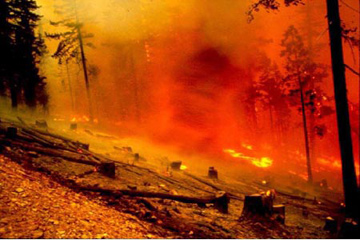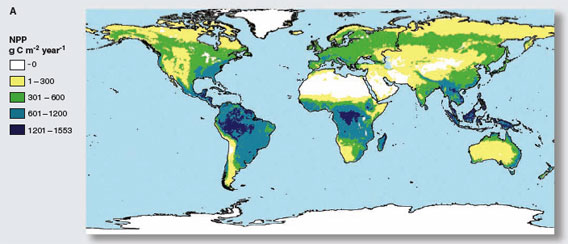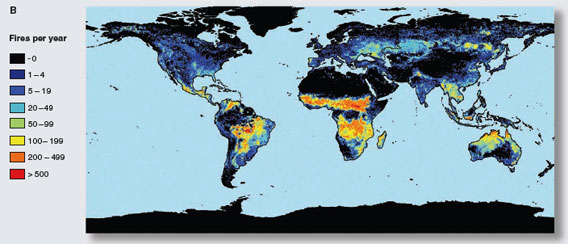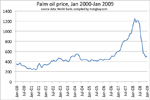Fire accounts for roughly half of greenhouse gas emissions from deforestation and about twenty percent of total emissions from human activities, report researchers writing in the journal Science. The estimates — based on analysis of fire’s impact on emissions of carbon dioxide, nitrous oxide, and methane; albedo or the reflectivity of Earth’s surface; and release of aerosols and other particulates — suggest fire plays a major large role in climate than conventionally believed.
“It’s very clear that fire is a primary catalyst of global climate change,” said Thomas W. Swetnam of the University of Arizona in Tucson, one of 22 co-authors of the report.
 The Kelsey Complex fire ranges in the Klamath National Forest, in 1987. Photo courtesy of Florida Division of Forestry. |
“We’ve estimated that deforestation due to burning by humans is contributing about one-fifth of the human-caused greenhouse effect — and that percentage could become larger.”
Other research suggests that higher temperatures could trigger a feedback effect whereby emissions from forests will increase due to reduced rainfall and increased incidence of fire and tree-killing pest outbreaks. Increased emissions will in turn exacerbate these impacts.
“Fires are obviously one of the major responses to climate change, but fires are not only a response — they feed back to warming, which feeds more fires,” said Swetnam.


Some of the world’s most carbon-dense ecosystems are increasingly susceptible to fire. (A) Net primary productivity in grams of carbon per square meter per year from 2001 to 2006 and (B) annual average number of fires observed by satellite. Images courtesy of Science.
While cautioning that their work is an early attempt to quantify the impact of fire on climate, the authors put forth some estimates for sources of emissions from fire. For example, CO2 emissions due to deforestation since 1750 is estimated at 182-199 billion tons carbon (total fossil fuel emissions since 1750 are estimated at 315 billion tons), while fire is estimated to contribute around 4 percent of total methane emissions and around 5 percent of nitrous oxide emissions.
The authors say a better understanding of the climate impact of fire will enable scientists develop models to more accurately forecast future future change — important given the rising economic toll from uncontrolled burning. Fires in Southeast Asia and Latin America during the 1997–1998 El Niño event caused some $19-24 billion in losses, including billions of dollars in human health costs.
“There is growing awareness of the deleterious
effects of such uncontrolled fires on biodiversity,
human health, and the economy. However,
there remains a serious lack of knowledge about
fire’s fundamental role in Earth system processes,
as well as an insufficient appreciation of
fire’s interaction with anthropogenic global environmental
change,” the authors write.
“For example, though the Intergovernmental
Panel on Climate Change (IPCC)
report concluded that global climate change will
increase the risk of extreme fire events (7), its
assessment did not quantify potential fire-climate
feedbacks. In order to achieve a better understanding
of fire, it must be understood as an integral
Earth system process that links and influences
regional and global biogeochemical cycles, human
activity, and vegetation patterns. Failure to
develop a coordinated and holistic fire science
will slow efforts to adapt to changing fire regimes
and manage fire.”
CITATION: David Bowman et al (2009) Fire in the Earth System. SCIENCE VOL 324 24 APRIL 2009
Related articles
Drought threatens the Amazon rainforest as a carbon sink

(03/05/2009) Drought in the Amazon is imperiling the rainforest ecosystem and global climate, reports new research published in Science. Analyzing the impact of the severe Amazon drought of 2005, a team of 68 researchers across 13 countries found evidence that rainfall-starved tropical forests lose massive amounts of carbon due to reduced plant growth and dying trees. The 2005 drought — triggered by warming in the tropical North Atlantic rather than el Niño — resulted in a net flux of 5 billion tons of carbon dioxide (CO2) into the atmosphere — more than the combined annual emissions of Japan and Europe — relative to normal years when the Amazon is a net sink for 2 billion tons of CO2.
New fire record for Borneo, Sumatra shows dramatic increase in rainforest destruction

(02/22/2009) Destruction of rainforests and peatlands is making Indonesia more susceptible to devastating forest fires, especially in dry el Niño years, report researchers writing in the journal Nature Geoscience. Constructing a record of fires dating back to 1960 for Sumatra and Kalimantan (on the island of Borneo) using airport visibility records to measure aerosols or “haze” prior to the availability of satellite data, Robert Field of the University of Toronto and colleagues found that the intensity and scale of fires has increased substantially in Indonesia since the early 1990s, coinciding with rapid expansion of oil palm plantations and industrial logging.
Burning rainforests, melting tundra could accelerate global warming well beyond current projections
![]()
(02/16/2009) Projections by the Intergovernmental Panel on Climate Change (IPCC) likely underestimate the scale and rapidity of climate change, warned a Stanford University scientist presenting Saturday at the annual meeting of the American Association for the Advancement of Science (AAAS) in Chicago.
Drought and deforestation in southeast Asia linked to climate change
(12/09/2008) Researchers have linked drought and deforestation in southeast Asia to climate change. Analyzing six years of climate and fire data from satellites, Guido van der Werf and colleagues report that burning of rainforests and peatlands in Indonesia, Malaysia, and Papua New Guinea released an average of 128 million tons of carbon (470 million tons of carbon dioxide – CO2) per year between 2000 and 2006. Fire emissions showed highly variability during the period, but were greatest in dry years, such as those that occur during El Niño events. Borneo was the largest source of fire emissions during the period, averaging 74 million tons per year, followed by Sumatra, which showed a doubling in emissions between 2000 and 2006.